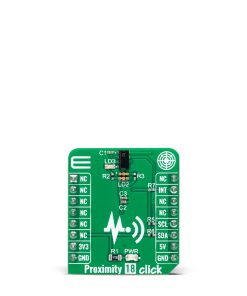Proximity 18 Click
R330.00 ex. VAT
Proximity 18 Click is a compact add-on board that provides a close-range proximity sensing solution. This board features the VCNL3036X01, a high-resolution digital proximity sensor from Vishay Semiconductors. Besides the proximity sensing element, the VCNL3036X01 also integrates a mux and a driver for three external LEDs, which are located near the chip on the board, photodiodes, amplifiers, and analog to digital conversion circuits into a single CMOS chip. Proximity 18 Click provides absolute distance measurement, whatever the target color and reflectance, and is accurate up to 50cm. This Click board™ is suitable for proximity/optical switch applications for consumer, computing, automotive, and industrial purposes.
Proximity 18 Click is supported by a mikroSDK compliant library, which includes functions that simplify software development. This Click board™ comes as a fully tested product, ready to be used on a system equipped with the mikroBUS™ socket.
Stock: Lead-time applicable.
| 5+ | R313.50 |
| 10+ | R297.00 |
| 15+ | R280.50 |
| 20+ | R269.94 |


























